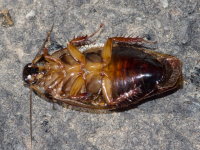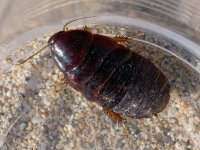Phylum Arthropoda (Arthropods) ➔ Subphylum Hexapoda (Hexapods) ➔ Class Insecta (Insects) ➔ Order Blattodea (Cockroaches, termites) ➔ Family Blaberidae (Giant cockroaches)
Pycnoscelus surinamensis (Linnaeus, 1758)
Gewächshausschabe Surinam Cockroach
Synonyms and other combinations:
Blatta corticum Serville, 1838 | Blatta melanocephala Stoll, 1813 | Blatta surinamensis Linnaeus, 1758 | Epilampra dimorpha Shiraki, 1906 | Epilampra tatei Tepper, 1894 | Panchlora celebesa Walker, F., 1868 | Panchlora occipitalis Walker, F., 1871 | Perispherus laevis Le Guillou, 1841 | Polyzosteria crassipes Walker, F., 1868 | Polyzosteria latipes Walker, F., 1868 | Pycnoscelus obscurus Scudder, 1862 | Pycnoscelus surinamensis major Roeser, 1940 | Pycnoscelus surinamensis minor Roeser, 1940 |
Further vernacular names:
Greenhouse CockroachDistribution:
Circumtropical (Asian origin)Habitat:
Tropics and subtropics. In temperate climates, Pycnoscelus surinamensis can be found in protected places, especially in greenhouses. The burrowing species lives in loose, sandy soil or beneath trash and debris.Description:
The predominantly dark brown imagines are about 18 - 25 mm long. They have slightly lighter, shiny brown wings. The front edge of the dark pronotum shows a pale band.The nymphs have a broad, brown body, which appears shiny in the front and rather dull in the back.
Biology:
Both the nimble larvae and the imagines of the Surinam Cockroach Pycnoscelus surinamensis are nocturnal. They live underground in loose soil, under litter, mulch or similar materials and feed on plant matter. In greenhouses, they cause damage especially to the roots, which leads to the death of the plants.The Greenhouse or Surinam Cockroach Pycnoscelus surinamensis proliferates parthenogenetically. Parthenogenesis is a form of single-sex reproduction in which offspring develop from unfertilized egg cells.
The bisexual form is often considered as a separate species and called Pycnoscelus indicus (Fabricius, 1775).
The Surinam Cockroach is oviviviparous. The females produce yolk-rich eggs that are not immediately deposited. The embryos developing in the eggs feed on the egg yolk. The larvae hatch either still in the mother's body or shortly after oviposition.
References, further reading, links:
- Beccaloni G.W. (2016). CockroachSF: Cockroach Species File (version 5.0/5.0, Dec 2015). In: Species 2000 & ITIS Catalogue of Life, 2016 Annual Checklist (Roskov Y., Abucay L., Orrell T., Nicolson D., Flann C., Bailly N., Kirk P., Bourgoin T., DeWalt R.E., Decock W., De Wever A., eds). Digital resource at www.catalogueoflife.org/annual-checklist/2016. Species 2000: Naturalis, Leiden, the Netherlands. ISSN 2405-884X.
- William J. Bell; Louis M. Roth; Christine A. Nalepa: Cockroaches: Ecology, Behavior, and Natural History, The Johns Hopkins University Press, Baltimore, 2007






